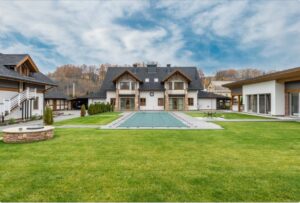 The foundation plays a vital role in green building projects, providing the necessary support for long-term sustainability and energy efficiency. But while there is much that can be done to ensure your foundation is as efficient as possible, it’s easy to overlook some important considerations when planning your next project. From responding to the site conditions and employing environmentally conscious design techniques, to selecting suitable materials with high-level thermal performance – factors that must be considered if you are aiming for an energy-efficient design. Here we explore how best to go about setting strong foundations on which your entire green building project can be built upon!
The foundation plays a vital role in green building projects, providing the necessary support for long-term sustainability and energy efficiency. But while there is much that can be done to ensure your foundation is as efficient as possible, it’s easy to overlook some important considerations when planning your next project. From responding to the site conditions and employing environmentally conscious design techniques, to selecting suitable materials with high-level thermal performance – factors that must be considered if you are aiming for an energy-efficient design. Here we explore how best to go about setting strong foundations on which your entire green building project can be built upon!
Defining Foundation and its Importance for green building projects
The foundation is a crucial aspect of any building – it serves as the base to ensure that a structure is stable and secure. In green building projects, the importance of foundation is magnified because it sets the foundation for environmentally-friendly construction practices. Essentially, it becomes the bedrock for sustainable development. Whether it’s using materials that have a smaller carbon footprint or incorporating energy-efficient methodologies, the foundation of a green building project sets the stage for the rest of the construction process. Moreover, a strong foundation ensures that the building lasts long without succumbing to damage or decay, making it an investment for the future. With the right foundation in place, it becomes much easier to create a space that is functional, eco-friendly, and fulfilling.
The types of foundation materials available for green building projects
When it comes to green building projects, one of the most important decisions is selecting the right foundation materials. Fortunately, there are several options available for builders to choose from. For example, one alternative is using rammed earth, which is made by compressing layers of soil into thick walls. Another popular choice is utilizing insulated concrete forms, which involve pouring concrete into styrofoam molds. A third option is building with recycled materials, such as old tires or broken glass, which can be used to create foundations that are both eco-friendly and cost-effective. Overall, the use of sustainable foundation materials is a critical factor for ensuring that green buildings are constructed in a way that is both environmentally friendly and financially viable.
How to select the best foundation material for your project
Choosing the right foundation material for your project is vital to ensure its structural integrity and longevity. The first step is identifying the load-bearing capacity required for your building. Consider the geographical location, soil type, and water table level. It’s important to find the right balance between cost, availability, and durability. Concrete is the most common choice for foundations due to its strength, versatility, and long lifespan. However, if you’re building on clay or sandy soil, you may need to use a more specialized material such as helical piers or screw piles, which can be more expensive but provide added stability. Ultimately, it’s crucial to consult with a professional engineer to assess your site’s individual needs and ensure you select the best foundation material for your project.
Tips for proper installation that will ensure a solid foundation
The strength and stability of any structure depend on its foundation, making proper installation crucial. To ensure a solid foundation, there are several tips to keep in mind. Firstly, proper site preparation is paramount. The ground must be leveled, and any debris or vegetation removed before the foundation can be laid. Secondly, the foundation must be constructed using quality materials and designed by a qualified professional such as levelprofoundationrepair.com. Failure to do so can result in a weak foundation that can compromise the entire structure. Lastly, regular maintenance and inspections are necessary to ensure the foundation remains strong over time. By following these tips, you can guarantee a solid foundation that will withstand the test of time.
Foundation maintenance to extend the lifespan of your project
When it comes to building a structure, one needs to make sure that the foundation is solid and robust. The foundation serves as the backbone of the entire project, and if it gets affected, it can affect the integrity of the entire construction. That is why foundation maintenance is essential to ensure the stability and safety of the structure. Proper foundation maintenance can help extend the lifespan of the construction, prevent costly repairs, and maintain the value of the property. By investing in foundation maintenance, property owners can have peace of mind knowing that their project is built to last. So, if you want to ensure the longevity of your construction project, make sure that you prioritize foundation maintenance.
Benefits of investing in the long-term future of your green building project
Investing in the long-term future of your green building project can reap countless benefits. First and foremost, it can drastically reduce your building’s environmental impact.
By implementing sustainable materials, energy-efficient systems, and other eco-friendly practices, you can significantly decrease your building’s carbon footprint. This not only benefits the environment, but it can also save you money on energy and maintenance costs in the long run.
Additionally, investing in the long-term future of your green building project can also increase its overall value. As more and more people become environmentally conscious, the demand for sustainable buildings continues to grow.
By prioritizing green building practices now, you can ensure that your building remains competitive and attractive to potential buyers or tenants in the future. Overall, investing in the long-term future of your green building project is a smart financial decision that supports both the environment and your bottom line.
In summary, we can all benefit from investing in a solid foundation for green building projects. Whether you choose masonry blocks, poured concrete, or engineered lumber like I-joists and glulam beams, proper installation and proper maintenance will help extend the life of your green building project and ensure that you have a solid foundation for years to come. Investing in the long-term future of your green building project is an investment in our collective future, as sustainable practices become increasingly important in today’s world. We should all take steps to build a more eco-friendly and sustainable future for ourselves and those around us.

